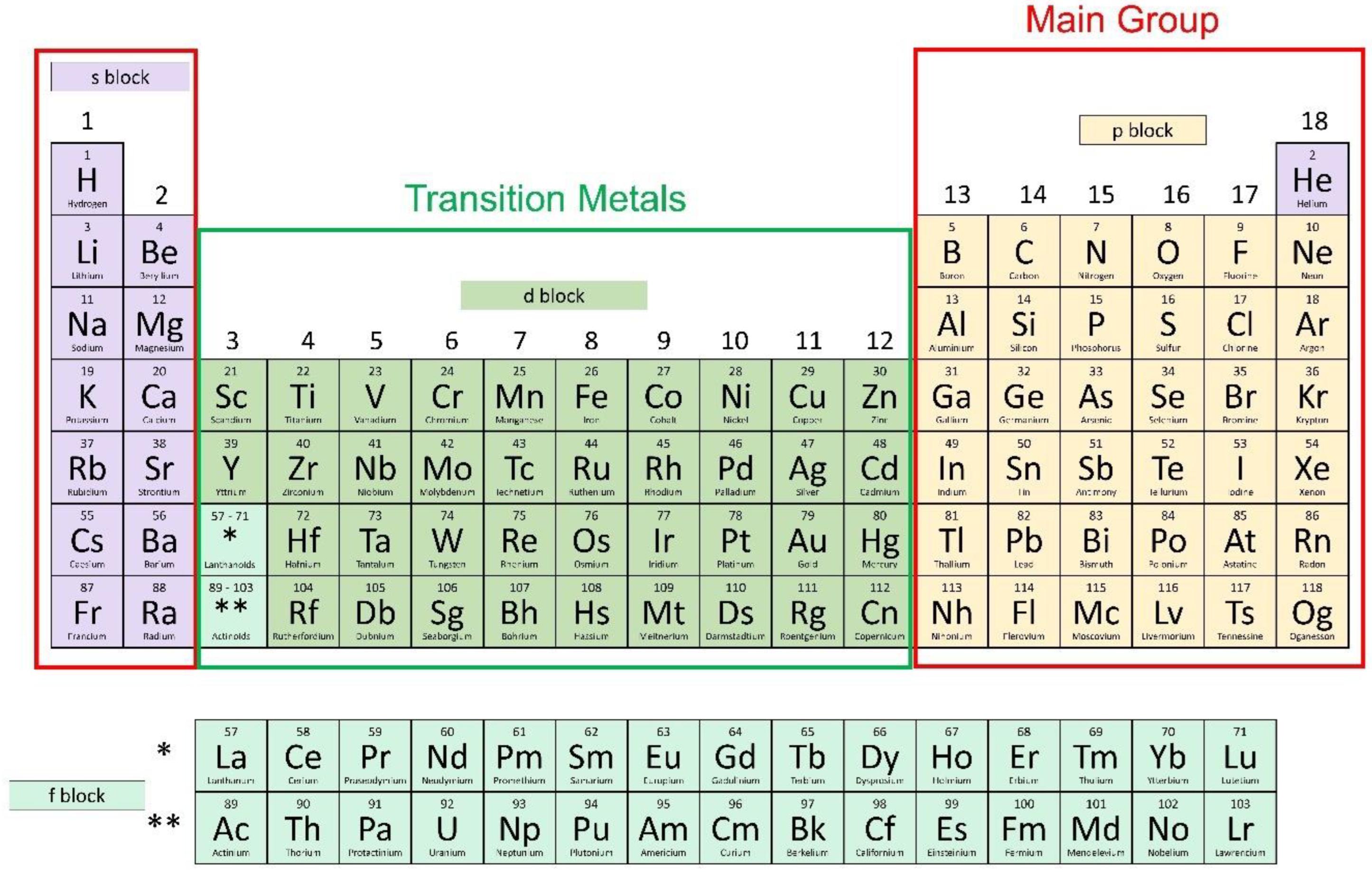Synergy between Main Group and Transition Metal Chemistry
Conflicts of Interest
References
- NobelPrize.org. The Nobel Prize in Chemistry 1913. Available online: https://www.nobelprize.org/prizes/chemistry/1913/summary/ (accessed on 24 February 2023).
- Housecroft, C.E.; Sharpe, A.G. Inorganic Chemistry; Pearson Education Limited: Harlow, UK, 2001. [Google Scholar]
- Tolman, C.A. Steric effects of phosphorus ligands in organometallic chemistry and homogeneous catalysis. Chem. Rev. 1977, 77, 313–348. [Google Scholar] [CrossRef]
- Mulvey, R.E.; Mongin, F.; Uchiyama, M.; Kondo, Y. Deprotonative Metalation Using Ate Compounds: Synergy, Synthesis, and Structure Building. Angew. Chem. Int. Ed. Engl. 2007, 46, 3802–3824. [Google Scholar] [CrossRef] [PubMed]
- Khusnutdinova, J.R.; Milstein, D. Metal–Ligand Cooperation. Angew. Chem. Int. Ed. Engl. 2015, 54, 12236–12273. [Google Scholar] [CrossRef] [PubMed]
- Elmakki, M.A.E.; Alexander, O.T.; Venter, G.J.S.; Venter, J.A.; Roodt, A. Structural Study of Model Rhodium(I) Carbonylation Catalysts Activated by Indole-2-/Indoline-2-Carboxylate Bidentate Ligands and Kinetics of Iodomethane Oxidative Addition. Inorganics 2022, 10, 251. [Google Scholar] [CrossRef]
- Sullivan, H.S.I.; Straiton, A.J.; Kociok-Köhn, G.; Johnson, A.L. N–O Ligand Supported Stannylenes: Preparation, Crystal, and Molecular Structures. Inorganics 2022, 10, 129. [Google Scholar] [CrossRef]
- Woodward, M.S.; King, R.P.; Bannister, R.D.; Grigg, J.; McRobbie, G.; Levason, W.; Reid, G. Fluoro-Germanium (IV) Cations with Neutral Co-Ligands—Synthesis, Properties and Comparison with Neutral GeF4 Adducts. Inorganics 2022, 10, 107. [Google Scholar] [CrossRef]
- Belay, A.N.; Venter, J.A.; Alexander, O.T.; Roodt, A. Synthesis, Single Crystal X-ray Structure, Spectroscopy and Substitution Behavior of Niobium(V) Complexes Activated by Chloranilate as Bidentate Ligand. Inorganics 2022, 10, 166. [Google Scholar] [CrossRef]
- Murphy, F.; Kennedy, A.R.; Weetman, C.E. Synthesis and Structural Comparisons of NHC-Alanes. Inorganics 2023, 11, 13. [Google Scholar] [CrossRef]
- Charman, R.S.C.; Horsley Downie, T.M.; Jerome, T.H.; Mahon, M.F.; Liptrot, D.J. Reactivity and Stability of a Ring-Expanded N-Heterocyclic Carbene Copper(I) Boryl Imidinate. Inorganics 2022, 10, 135. [Google Scholar] [CrossRef]
- Cleaves, P.A.; Gourlay, B.; Marseglia, M.; Ward, D.J.; Mansell, S.M. Digold Phosphinine Complexes Are Stable with a Bis(Phosphinine) Ligand but Not with a 2-Phosphinophosphinine. Inorganics 2022, 10, 203. [Google Scholar] [CrossRef]

Disclaimer/Publisher’s Note: The statements, opinions and data contained in all publications are solely those of the individual author(s) and contributor(s) and not of MDPI and/or the editor(s). MDPI and/or the editor(s) disclaim responsibility for any injury to people or property resulting from any ideas, methods, instructions or products referred to in the content. |
© 2023 by the author. Licensee MDPI, Basel, Switzerland. This article is an open access article distributed under the terms and conditions of the Creative Commons Attribution (CC BY) license (https://creativecommons.org/licenses/by/4.0/).
Share and Cite
Mansell, S.M. Synergy between Main Group and Transition Metal Chemistry. Inorganics 2023, 11, 98. https://doi.org/10.3390/inorganics11030098
Mansell SM. Synergy between Main Group and Transition Metal Chemistry. Inorganics. 2023; 11(3):98. https://doi.org/10.3390/inorganics11030098
Chicago/Turabian StyleMansell, Stephen M. 2023. "Synergy between Main Group and Transition Metal Chemistry" Inorganics 11, no. 3: 98. https://doi.org/10.3390/inorganics11030098
APA StyleMansell, S. M. (2023). Synergy between Main Group and Transition Metal Chemistry. Inorganics, 11(3), 98. https://doi.org/10.3390/inorganics11030098




